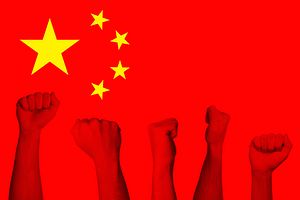How often do protests occur in China? It’s indisputable that the one-party state has established an unprecedented system to stop collective action before it starts – featuring pervasive surveillance, grid-management policing, and even a “targeted population” system to control citizens thought to have a propensity for activism. Xi Jinping has taken social control even further as he has consolidated dictatorship over the past decade, inducting a raft of new security laws and closing space for rights advocacy NGOs. Furthermore, the government goes to great lengths to keep citizens from sharing information about dissent.
In this context, someone could be forgiven for believing that protests in China are uncommon. Yet, a new Freedom House initiative, the China Dissent Monitor (CDM), has found that people in China frequently challenge those in power, both collectively and individually. CDM documented 668 incidents of protest and other forms of dissent in mainland China from June to September 2022. Of these, 77 percent were demonstrations, marches, and obstructing roads. We documented many other modes of dissent as well, including occupations, strikes, protest banners and graffiti, and notable online dissent such as large-scale hashtag campaigns and viral posts.
Dissent in China looks like this:
- After their children suffered food poisoning, hundreds of parents in Xi’an protested outside the tutoring company Kid Castle. Police violently repressed the demonstration.
- A large group of people, all of whom had purchased apartments in the Zoina Spring property in Hangzhou, demonstrated against wrongdoings by the real estate developer. They shouted “police brutality!” when state security agents began to drag away protesters.
- Unhappy that a newly constructed road bypassed the entrance to their village, residents in Hebei blocked the road with bicycles and motorbikes.
- Construction workers in Shenyang hung banners on a residential building to demand unpaid wages from the developer, Zhongliang.
- Hundreds of thousands of Weibo users criticized authorities over COVID-19 policies, using a hashtag linked to the arrest of a woman and her father in Dandong for resisting pandemic restrictions in order to travel to a hospital for treatment.
Such protests are a daily occurrence in China, and CDM is documenting them. The project categorizes each event across several variables, enabling comparisons and trend analysis, and puts all the information into a regularly updated database at chinadissent.net.
Not only is dissent in China frequent, it’s also widespread. Since June, people have protested in nearly every province and directly administered city. Moreover, even as authorities make every effort to prevent protestors from connecting, we found many instances where people manage to form decentralized movements that increase the impact of their dissent. For example, the Henan depositors’ movement involved bank customers from at least five provinces protesting Henan-based banks that froze withdrawals. International reporting focused on one large demonstration in July, but CDM recorded 16 separate events connected to this movement since June.
Another example was the real-name complaints movement in June, which involved 61 demonstrations against corruption, abuse of power, and corporate fraud across 17 provinces and 35 cities, linked by the use of shared symbolism as protesters held up their ID cards while stating grievances.
While it’s not accurate to paint protest as uncommon in Xi’s China, it would also not be quite right to describe the typical protest as explicitly challenging the one-party regime. While CDM does record challenges to central leadership – for example, when three long-time Chinese Communist Party (CCP) members published an open letter in August calling on the party to revise its principle that the “party leads everything” – most protest actions target local government (33 percent) and private companies (64 percent). The issues that most often galvanized people included stalled housing, fraud, labor rights violations, COVID-19 policies, corruption, and land rights. And importantly, CDM found evidence of the target responding to citizens’ demands in at least 37 cases, such as government opening investigations or making policy changes, or companies paying due wages.
Yet even as citizens aren’t usually challenging the political system outright, authorities often treat their actions as a threat. There is evidence of repression in a quarter of all dissent events in the CDM database, including 60 instances of state violence and 48 instances of detention or arrest, each often involving multiple people. And this is likely an undercount. CDM only records repression when there is direct evidence such as photos and videos, but reprisals may occur after these snapshots in time.
Repression is common not because citizens’ actions threaten the one-party regime directly, but because the CCP treats the act of collectively, publicly challenging any authority – whether village officials or a powerful company engaged in fraud – as a potential threat, particularly when the protesters can win concessions. This is why “social stability” is ingrained in all levels of governance and ability to enforce it is among the top metrics considered for party cadre promotion. It is why Xi has put so much emphasis on choking civic space and securitizing society: the aim is to reduce the ability of citizens to mobilize.
Despite years of concerted efforts to control and silence their voices, people in China are speaking out in the streets, in their communities, on banners, on walls, in cyberspace, collectively, and individually. In small ways and large, they organize to challenge injustices pertinent to them and their communities, to seek redress, and to hold the powerful to account. CDM will continue to document and share their stories.

































